Choosing a Gaming CPU at 1440p: Adding in Haswell
by Ian Cutress on June 4, 2013 10:00 AM ESTCivilization V
A game that has plagued my testing over the past twelve months is Civilization V. Being on the older 12.3 Catalyst drivers were somewhat of a nightmare, giving no scaling, and as a result I dropped it from my test suite after only a couple of reviews. With the later drivers used for this review, the situation has improved but only slightly, as you will see below. Civilization V seems to run into a scaling bottleneck very early on, and any additional GPU allocation only causes worse performance.
Our Civilization V testing uses Ryan’s GPU benchmark test all wrapped up in a neat batch file. We test at 1440p, and report the average frame rate of a 5 minute test.
One 7970

Civilization V is the first game where we see a gap when comparing processor families. A big part of what makes Civ5 perform at the best rates seems to be PCIe 3.0, followed by CPU performance – our PCIe 2.0 Intel processors are a little behind the PCIe 3.0 models. By virtue of not having a PCIe 3.0 AMD motherboard in for testing, the bad rap falls on AMD until PCIe 3.0 becomes part of their main game.
Two 7970s
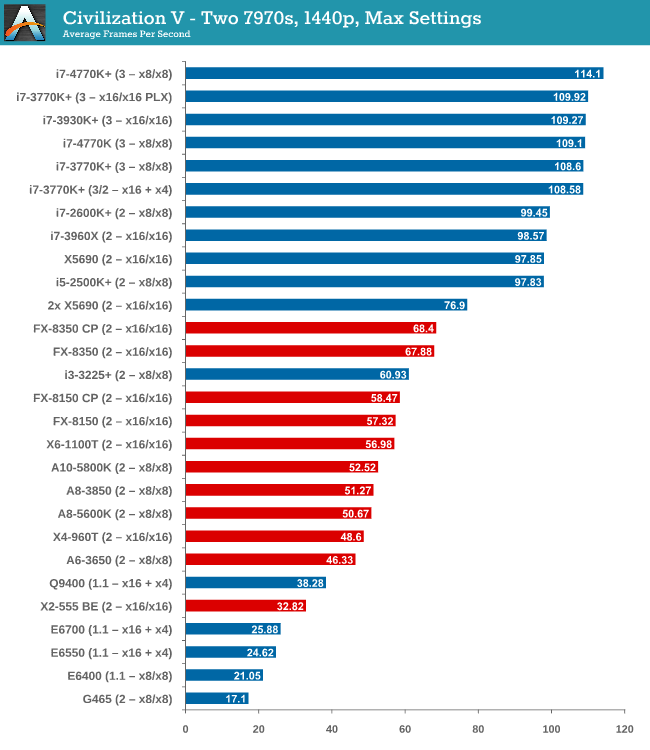
The power of PCIe 3.0 is more apparent with two 7970 GPUs, however it is worth noting that only processors such as the i5-2500K and above have actually improved their performance with the second GPU. Everything else stays relatively similar.
Three 7970s
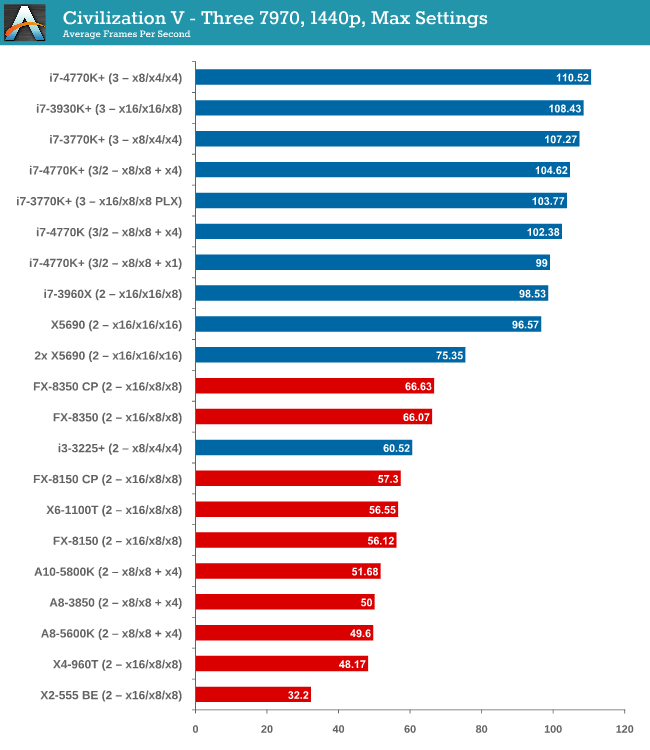
More cores and PCIe 3.0 are winners here, but no GPU configuration has scaled above two GPUs.
Four 7970s
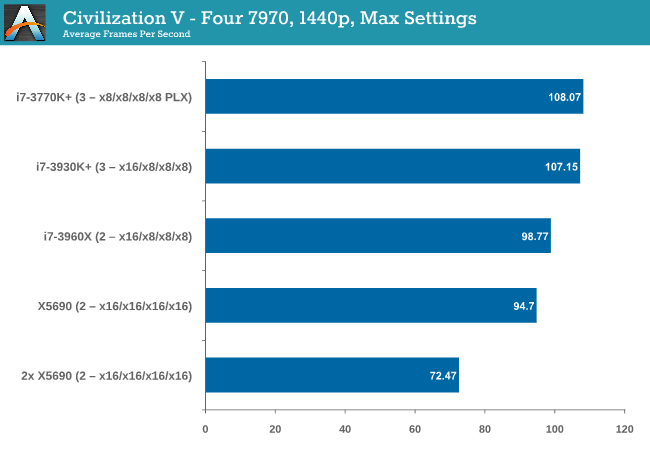
Again, no scaling.
One 580
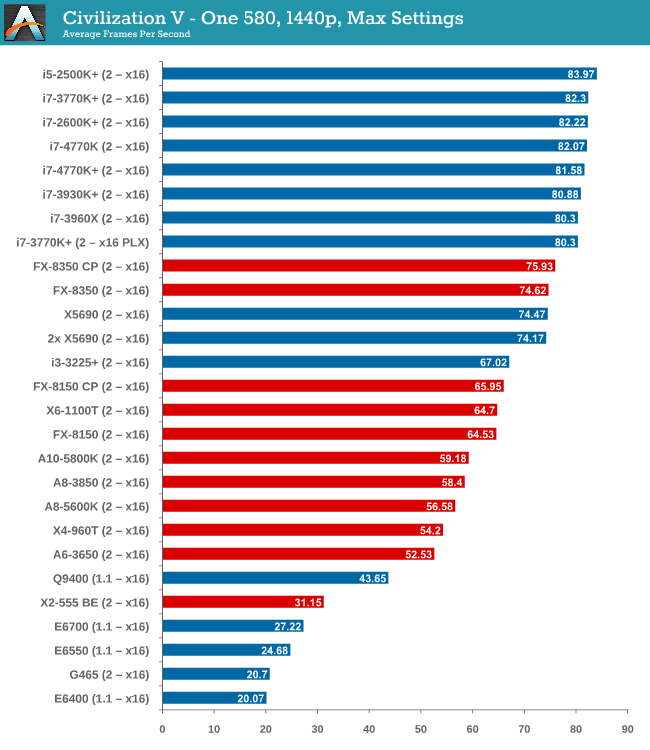
While the top end Intel processors again take the lead, an interesting point is that now we have all PCIe 2.0 values for comparison, the non-hyper threaded 2500K takes the top spot, 10% higher than the FX-8350.
Two 580s
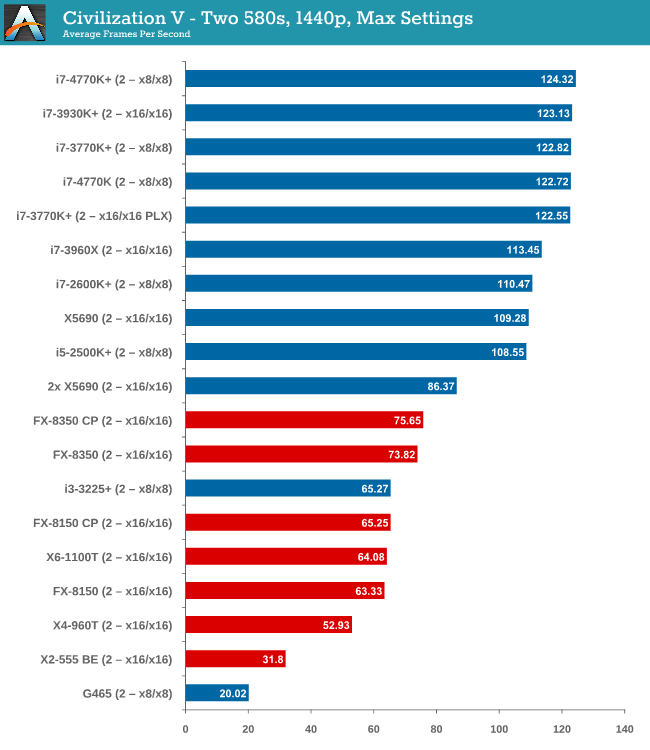
We have another Intel/AMD split, by virtue of the fact that none of the AMD processors scaled above the first GPU. On the Intel side, you need at least an i5-2500K to see scaling, similar to what we saw with the 7970s.
Civilization V conclusion
Intel processors are the clear winner here, though not one stands out over the other. Having PCIe 3.0 seems to be the positive point for Civilization V, but in most cases scaling is still out of the window unless you have a monster machine under your belt.










116 Comments
View All Comments
gonks - Tuesday, June 4, 2013 - link
Great work Ian! Definitely waiting to see i5-3570K added into the mix, to see how it compares to the i5-2500k (and the 3570k beeing more futureproof thanks to PCIe 3.0).Harby - Tuesday, June 4, 2013 - link
Excellent review, though it would be awesome to see World of Warcraft and Rift in there. Both are heavily relying on CPU.yougotkicked - Tuesday, June 4, 2013 - link
As always, thanks for the great article and hard work Ian.I'd really like to see how a few of the tests scale with overclocked CPU's, notably those in which the sandy bridge processors were competitive with ivy bridge and haswell parts. Obviously overclocking introduces a lot of variables into your testing, but it would be very interesting to see a few of the popular choices tested (sandy bridge parts @ 4.5 are quite common, and many users on such a system were waiting for haswell before they upgrade).
eBombzor - Tuesday, June 4, 2013 - link
Crysis 3 benchmarks PLEASE!!frozentundra123456 - Tuesday, June 4, 2013 - link
Interesting results, but very limited as well. Why test at a resolution used by only 4% of the players?I would have rather seen the results at 1080p, over a wider variety of games. Especially RTS games and newer games like crysis 3, FC3, and Tomb Raider. I tested Heart of the Swarm on my computer with a HD7770 and i5 2320 and was able to max out the cpu in a 10 player skirmish match at ultra, 1080p. So I am sure an A8-5600 would be limiting in that case.
Even considering the results only of the games tested, the A8-5600k seems a strange choice. The i3 seems just as valid, considering it is equal or faster in every game but one, while using less power.
makerofthegames - Tuesday, June 4, 2013 - link
Question - are those blank entries for the Xeons because they could not run, or just that data was not collected for them?Awful - Tuesday, June 4, 2013 - link
Glad to see there's no reason to upgrade the i5-2500k in my desktop yet - still happily chugging away at 4.9GHz after 2 years!holistic - Tuesday, June 4, 2013 - link
Ian,Thank you, for your time, effort, and energy in compiling an encyclopedic database on the effects of cpu on single and multi gpu configurations, in alternate gaming/engine scenarios. Your work is insightful, informative, and wholly devoted to the science of benchmarking. This approach has helped me, as a relatively new computer enthusiast, to more deeply understand testing methodology in the computing field.
I am interested in the pure CPU benchmarks of Starcraft 2 with the 4770k and 4670k. I understand this game is not optimized, is directx9, and is extremely cpu limited with only 2 maximum cores active, and thus not in top priority for providing benchmarks. Will haswell be added to the benchmarking database for sc2?
Cheers,
Craig
khanov - Tuesday, June 4, 2013 - link
Ian, I have to say (again) that i7-3820 should be in this review.You say that i7-4770K is a better value proposition than Sandy Bridge-E (X79), I assume because you are only thinking of the expensive 6 core X79 CPU's. That changes if you do consider i7-3820.
X79 brings far better support for multi-gpu setups with enough PCIe lanes to feed multiple cards quite happily. No PLX needed. Pair that with an i7 3820 (cheaper than i7-3770K/i7-4770K) and you may find the performance surprisingly good for the price.
chizow - Friday, June 7, 2013 - link
I considered the 3820 numerous times (it's cheap at MC, same price as high-end 3770K/4770K) but I shy away because it inexplicably performs *WORST* than 2700K/3770K/4770K. I don't know why, it has more L3 cache, and is clocked higher before/after boost. Just an oddball chip.Besides, X79 as a platform was dated almost as soon as it released. PCIe 3.0 support is spotty with Nvidia (reg hack not guaranteed), no native USB 3.0 and no full SATA 6G support. I went for Z87 + 4770K instead because X79 + 3820 didn't offer any noticeable advantages while carrying a significant higher price tag (board price).